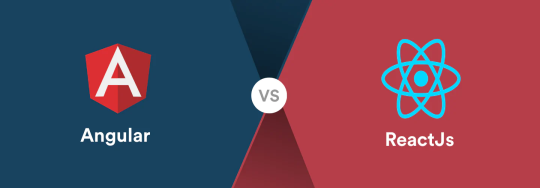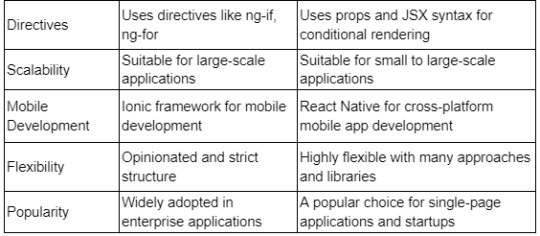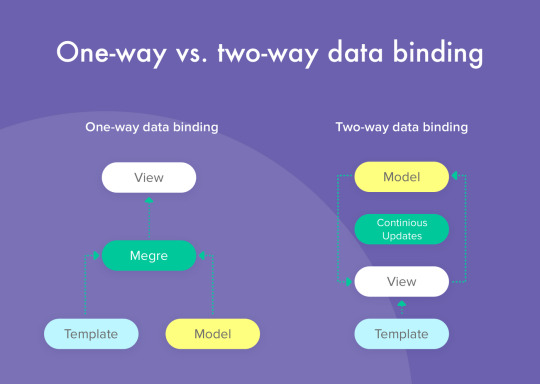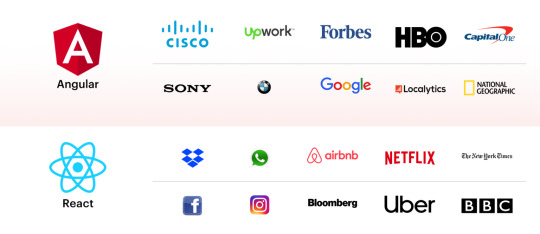#AngularJS vs ReactJS
Explore tagged Tumblr posts
Text
AngularJS vs ReactJS: Which One is Best for Next Front-end Development Project?
Choosing the right path for your next front-end development journey: Navigating the landscape of AngularJS and ReactJS to find the perfect fit for your project's success. 🚀 #AngularJS #ReactJS #FrontEndDevelopment #TechDecisions" https://jumpgrowth.com/angularjs-vs-reactjs/
0 notes
Text

Angular is a TypeScript-based, open-source JavaScrip framework. Google maintains this framework. By using HTML and TypeScript, it builds a single-page application. React is a flexible, efficient, declarative JavaScript library that helps create user interfaces. It is an open-source front-end JavaScript library. It is a user interface library. Vue is an open-source model-view-ViewModel front-end JavaScript framework. It is used for developing single-page applications and user interfaces. The article will show the differences between Angular vs React vs Vue.
#angularjs development company#reactjs development company#reactjs development services#angularjs development services#vue vs react vs angular#vuejs development company#vuejs development services
0 notes
Text
A practical guide to selecting your web frontend framework
When starting a new web application project, choosing the preferred web frontend framework can often be a long and serious point of discussion. In this article, we hope to provide developers with a guide to selecting a suitable web frontend framework for different types of projects. JavaScript or TypeScript When we talk about frontend web development in the year 2023 and for probably the next…

View On WordPress
#angular developer philippines#angular philippines#angularjs#frontend developer philippines#react philippines#react vs vue vs angular#reactjs#reactjs developer philippines#vue philippines#vuejs developer philippines#web design#web development#web programming
0 notes
Text
React and AngularJS are Javascript (JS) technologies that are widely used for creating one-page, interactive applications. JS tools are growing at a faster pace to target advancements in the technology. In the middle of all this, AngularJS vs ReactJS has become a popular topic of discussion. When used for business applications or websites, selection of a right framework out of these two is a high priority work. Why? Because AngularJS or ReactJs framework affects factor associated with an application’s durability, scalability, code maintainability and others. To clarify the competition to some extent, below are some parameters that show how React is more popular in 2018 Flexible Approach Angular offers defaults for state management, language choice, network connectivity and more. Developers using Angular need to follow these default settings. React on the other side, is a UI library and does not prescribe these mentioned features. But, React is an open ecosystem where developers can adapt to it as per their need. And, in this way, React is a flexible technology than Angular. TypeScript Angular uses Typescript as the development language which is the blend of Java and C#. People aware of these languages prefer to work in Angular and consider it as technically superior. However, developers that belong to a different background find it hard to work in Angular and feels like learning something very new is useless in the emerging technology involved with Javascript ecosystem. Solving this problem, for static typing, React offers both Typescript and Flow, a Facebook library. This is why React seems easy for most of the developers and thus selected often to build applications. Here again, flexibility is an asset for creating React applications. Paradigms Involved Javascript involves popular paradigms like OOPs and functional programming (FP). Understanding a paradigm’s principals is vital to produce a high-quality application dealing with all the development challenges. While Angular framework implements OOP like Typescripts, React has some roots in FP. When coupled with Redux, FP can be much more interesting than Angular in terms of predictable and manageable working of functions. FP has become popular due to React and has bright future applications. Simplicity Factor A simplified structure and learning curve of a programming language makes it easy for learning it faster. When it comes to AngularJS, it is not at all a simple framework to set up a project in. Though, it can be learned fast but creates confusion for the developers due to its complex libraries and syntax. On the other side, React is comparatively simple and easy to learn and work with. In programming, coders use AngularJS to create the core structure of front-end Javascript apps and ReactJS offers improvements to its parts. In short, developers can embrace easy and effective React framework for application building. Considering the factors above, React seems to be a default and popular choice for the new developers in the market. Though Angular and React frameworks both have a significant scope in future, React is growing faster and working with it is simpler as it has advanced tools.
0 notes
Text
ReactJS vs AngularJS: Which One Should You Choose?
Confused between ReactJS and AngularJS? Learn their pros, cons, and ideal use cases to make an informed decision for your web development needs.
1 note
·
View note
Text
Which is More Powerful, AngularJS or ReactJS?
Today, businesses seek tools and frameworks to build dynamic and engaging user interfaces.
The two prominent web app frameworks that are extremely used are- AngularJS and ReactJS. Each framework has unique strengths and specialties, catering to diverse project requirements and offering advanced tools and features to build modern-age web applications.
Whether you are a beginner or an experienced developer, you must understand these two popular frameworks, AngularJS vs. ReactJS.

Source- https://www.simform.com/blog/angular-vs-react/
In this blog, we will explore the common differences: Angular vs. Reactjs and where to use which framework.
Reactjs: Learn Once, Write Anywhere
ReactJS is a powerful JavaScript library for building user interfaces in web applications. It's known for its efficiency and uses a component-based approach, making UI development straightforward and organized.
React's virtual DOM ensures fast rendering by updating only the necessary parts of the webpage. JSX simplifies writing HTML within JavaScript, improving code readability. With one-way data binding, React ensures predictable data flow, making it easier to maintain and debug applications. These features make ReactJS a popular choice among developers for creating responsive and dynamic web interfaces.

Source- https://bestofjs.org/projects/react
Key features-
Declarative views
JSX advantage
Component-based
Virtual DOM
One-way data binding
Building blocks flexibility
Advantages of Reactjs-
ReactJS provides several benefits:
Developers can create reusable and predictable code.
Debugging is simplified with declarative views.
It reduces ReactJS Developer development time significantly.
It enhances developer productivity.
Transitioning between different React versions is seamless.
React Native facilitates mobile app development.
Updates are faster with server-side and front-end rendering support.
The UI is efficiently built for improved load times and performance.
It integrates smoothly with various third-party libraries and tools.
Hire the best Hire Reactjs Developers from OnGraph for advanced interfaces.
What is Angular?
Angular is a robust platform and framework for web development, built using TypeScript. It uses a component-based architecture to create scalable web applications. Angular accelerates front-end development with integrated libraries for tasks like client-server communication and routing. It comes with tools that work well for projects of any size, from small apps to large enterprise ones.

Source- https://bestofjs.org/projects/angular
Key features-
Two-way data binding
Dependency injection
Virtual scrolling
Angular CLI
Built-in libraries
Advantages of Angular-
It promotes strong encapsulation and follows an intuitive application structure.
Facilitates clean code development, enhancing maintainability.
Simplifies building, testing, and updating applications.
Includes built-in features like RxJS and Angular CLI for efficient development.
Built-in support for HTTP, AJAX, and Observables streamlines data handling.
Enables rapid server-side rendering and supports views without browser-side rendering.
Parallel component execution reduces the lines of code needed.
Boosts developer productivity and enhances application performance overall.
Also read: 13 Best React Frameworks and Libraries to Use in 2024
Angular vs. ReactJs: Tabular Difference


Detailed Comparision: Reactjs vs. Angular
1. Popularity
Both Angular and React have gained popularity in the developer community. React leads with 203k stars on GitHub and ranks second in a 2022 Statista survey on the most used web frameworks worldwide.
Angular, initially released as AngularJS, gained fame for single-page applications. Its redesign as Angular 2 in 2016 introduced new features, solidifying its maturity. However, React's rendering optimizations, virtual DOM, and easy component reuse have consistently made it the preferred choice for dynamic web applications.
2. Performance
Both Angular and React excel in building high-performing web applications, each with its unique strengths.
Angular prioritizes optimizing coding practices and performance enhancement through features like optimized digest cycles and $cacheFactory for efficient data memorization and recalculation. It uses real DOM with a sophisticated change detection mechanism that accelerates web app rendering.
On the other hand, React leverages its virtual DOM, which enables faster updates and data refreshes without rewriting the entire HTML document. It promotes component reusability across projects, enhancing developer productivity and maintaining code quality. These capabilities ensure both frameworks deliver efficient, scalable solutions for varying project complexities.
Hire a React JS development company for next-level React JS development services.
3. Data Binding

Source- https://www.tabnine.com/blog/angular-vs-react/
Angular and React handle state management differently. Angular uses two-way data binding, meaning changes in interface elements automatically update the model and vice versa. This simplifies building interactive interfaces without extra callbacks, making it ideal for complex applications like ERPs.
React, on the other hand, employs one-way data binding, where updates to the interface occur after the model state changes. This gives developers more control but requires managing state with libraries like Redux for complex applications. While Angular automates data binding, React provides flexibility with precise control over the application state.
4. Server-side Rendering
Angular: With server-side rendering, Angular pre-renders the application to create a static view before it becomes fully interactive. It optimizes server-side performance by efficiently using JSON and client-side caching, minimizing client-server communication.
React: React supports server-side rendering easily, making applications more SEO-friendly. It uses functions like RenderToString for this purpose, offering flexibility that sets it apart from other JavaScript frameworks.
5. Testing
Angular: Testing in JavaScript can be challenging due to its dynamic typing, requiring thorough testing to ensure code quality. Angular simplifies testing with features like unit code isolation and dependency injection, which facilitate easy component decoupling and mocking. It offers comprehensive testing and debugging tools within a single framework setup.
React: Testing in React involves mocking parts not present in testing environments to ensure reliable results, particularly in data-fetching scenarios. React provides predictable tests with robust mocking functions. It integrates test suites into the development process, using test runners like Mocha, Ava, and Jest for efficient test execution alongside ongoing development tasks.
6. Optimizing bundle size
The size of the initial bundle file downloaded when loading a webpage significantly affects how quickly the page displays. Both Angular and React developers focus on optimizing this bundle size for better application performance.
Angular: Angular applications require compilation before they can run in a browser. This compilation ensures that Angular's components and templates are understood by browsers. However, larger bundle sizes can slow down loading times. To speed up rendering, developers can use Ahead-of-Time (AOT) compilation. Although not the default, it can be activated through Angular CLI in production mode. AOT converts Angular's HTML and TypeScript code into efficient JavaScript during the build phase, improving load times.
React: Bundle size is crucial in React, especially as applications grow. It's essential to continually analyze and optimize the codebase to maintain performance. As new pages and features are added, the initial bundle size can increase significantly. Techniques like code-splitting and compression are vital for optimizing bundle sizes without slowing down the application. These methods help manage large app sizes effectively in React development.
7. Learning curve
Angular: Angular is extensive and dynamic. Initially, it covers fundamental topics like directives, modules, components, services, and dependency injection. Learning Angular may feel challenging at first due to its steep learning curve, especially compared to React.
React: React focuses on writing components, managing internal states, and using props for configuration. It may seem unfamiliar initially, but it's straightforward and doesn't add unnecessary complexity. Learning React's basics, along with state management and routing, prepares developers well for building applications.
Choosing between Angular and React depends on your project's requirements. Angular excels in solving complex problems in large-scale applications, while React's simplicity and flexibility have made it increasingly popular among developers. Both technologies offer robust features, tools, and performance capabilities, making it a tough choice for development teams.
When to Choose Angular vs. React
Angular
Angular excels in speeding up front-end development and is favored for creating robust, data-driven web applications. Maintained by Google, it offers stability and extensive community support. Here are scenarios where Angular is ideal for-
Designing, maintaining, and scaling large and complex applications due to its component and directive architecture.
Developing feature-rich elements and customizations efficiently.
Building enterprise-scale projects without needing extensive third-party integrations, could complicate development.
Choose Angular if you:
Need to create enterprise-grade applications with extensive features.
Manage projects of medium to high complexity.
Have developers skilled in languages like C#, Java, and Angular versions, ensuring high productivity.
Aim to develop applications like video streaming platforms, e-commerce sites, or real-time data apps.
React
React focuses on handling the view layer and excels in creating reusable UI components. It's known for its speed in updating data without reloading the page, originally developed by Facebook and widely adopted in large-scale applications like Instagram. Ideal use cases for React include:
Building customizable and interactive app solutions.
Creating apps with multiple events or shareable elements.
Projects where developers are proficient in JavaScript, HTML, and CSS.
Choose React if you:
Want to develop personalized applications tailored to specific needs?
Require dynamic and fast-loading interfaces for social networks, data dashboards, or retail apps.
Plan to build cross-platform mobile applications efficiently.
Understanding these distinctions will help you choose the right framework based on your project requirements and the development team's expertise.
Companies Using Angular vs. Reactjs

Source- https://www.simform.com/blog/angular-vs-react/
Angular or React - Which is Better?
Both Angular and React are widely used front-end technologies. While Angular offers great benefits, React stands out as the preferred choice. It has large community support and features like Virtual DOM and rendering optimizations that give it an edge over Angular.
React also makes version migration seamless and has a straightforward installation process. Overall, React streamlines development, reduces errors, and offers robust solutions. When choosing between React and Angular, consider your project needs and functionalities. For professional JavaScript development services, feel free to reach out to us confidently.
Connect with OnGraph, a leading React JS development agency for building exceptional front end and the best React JS development service.
Content Source URL: https://www.folkd.com/entry/56745-which-is-more-powerful-angularjs-or-reactjs/
#IsReactorAngularmoreindemand#ShouldIlearnAngularorReactin2024#reactjs#angularjs#DoesAngularorReactpaymore
0 notes
Text
Top Best ReactJS Development Company in India
As a leading ReactJS Development Company in India, Shilsha Technologies is dedicated to delivering exceptional web development services that cater to your project's needs. Our team of skilled ReactJS developers brings a wealth of experience and expertise to every project, ensuring that your web applications are not only high-performing but also scalable and maintainable.

We understand the importance of a strong online presence in today’s digital landscape, and ReactJS has emerged as a powerful tool for creating dynamic and responsive web applications. At Shilsha Technologies, we harness the full potential of ReactJS to craft user interfaces that are not only visually appealing but also offer seamless user experiences.
Why Use React for Web Development?
ReactJS is one of the most popular JavaScript libraries for building user interfaces, particularly for single-page applications where you want a fast, responsive user experience. Component-based architecture provides developers with encapsulated components that manage their states, making code management and debugging easier.
ReactJS is maintained by Facebook, which ensures continuous updates and community support, making it a reliable choice for long-term projects.
One of the key reasons React is used for web development is its flexibility. React can be used to build everything from simple websites to complex web applications. It integrates well with other libraries and frameworks, allowing developers to choose the technology stack that best suits the project requirements.
Additionally, React’s virtual DOM enhances the performance of web applications by updating only the parts of the page that need to change, rather than reloading the entire page. This results in a faster loading time and a smoother user interface.
What is the Main Advantage of Using React?
The main advantage of using React is its ability to create reusable components, which significantly speeds up the development process. These components can be used across different parts of an application or even in different projects, reducing the amount of repetitive code and ensuring consistency in the user interface. This modular approach not only saves time but also makes it easier to maintain and update the application as it grows.
React’s component-based structure also promotes better collaboration among developers. Teams can work on different parts of the application simultaneously without interfering with each other's work since each component can be developed, tested, and debugged independently. This parallel development process is especially beneficial for large projects with tight deadlines.
Moreover, React’s declarative syntax makes the code more predictable and easier to understand, which is particularly helpful when onboarding new developers or when the project needs to be handed over to a different team. The predictability of React code ensures fewer bugs and smoother collaboration, ultimately leading to a more efficient development process.
ReactJS vs AngularJS: Which is the Best Framework for Your Web Projects?
When choosing between ReactJS and AngularJS for your web projects, it’s important to understand the key differences between the two frameworks. ReactJS, as mentioned earlier, is a JavaScript library focused on building user interfaces, while AngularJS is a full-fledged framework that provides a comprehensive solution for building complex applications.
One of the main advantages of ReactJS over AngularJS is its simplicity and flexibility. ReactJS focuses solely on the view layer of an application, giving developers the freedom to choose their preferred tools for routing, state management, and other functionalities. This flexibility allows for greater customization and the ability to tailor the development process to the specific needs of the project.
On the other hand, AngularJS is a more opinionated framework, offering a complete set of tools out of the box. This can be advantageous for developers who prefer a structured approach and don’t want to spend time selecting and configuring additional libraries. However, this also means that AngularJS can be more complex and harder to learn, especially for developers who are new to front-end development.
In terms of performance, ReactJS has an edge due to its virtual DOM, which ensures efficient updates to the user interface. AngularJS uses a real DOM, which can lead to slower performance in larger applications. Additionally, ReactJS has a larger community and more extensive documentation, making it easier to find resources, tutorials, and third-party libraries.
Ultimately, the choice between ReactJS and AngularJS depends on the specific requirements of your project. If you need a lightweight, flexible solution for building user interfaces, ReactJS is the better choice. If you require a full-featured framework with a predefined structure, AngularJS might be more suitable.
How to Hire a ReactJS Developer
Hiring a ReactJS developer or Hire a developer in India is a crucial step in ensuring the success of your web project. When looking for a ReactJS developer, consider their experience, expertise, and familiarity with the latest ReactJS features and best practices. At Shilsha Technologies, we have a team of experienced ReactJS developers who are well-versed in creating high-performance web applications customized to your business needs.
Start by defining the scope of your project and the specific skills you need. Look for developers with a strong portfolio of ReactJS projects and a deep understanding of JavaScript, HTML, and CSS. Additionally, consider their ability to work with related technologies like Redux for state management and TypeScript for type safety.
During the interview process, assess the developer’s problem-solving skills and their ability to work collaboratively in a team environment. Ask them to walk you through their previous projects and explain how they approached challenges, optimized performance, and ensured code quality. It’s also important to evaluate their communication skills, as effective collaboration is key to the success of any development project.
At Shilsha Technologies, we make the hiring process easy by offering a dedicated team of ReactJS developers who are ready to bring your vision to life. Whether you need to build a new application from scratch or enhance an existing one, our developers have the expertise to deliver high-quality results on time and within budget.
ReactJS has proven to be a powerful tool for building dynamic, responsive web applications. Its component-based architecture, virtual DOM, and flexibility make it a top choice for modern web development. As a ReactJS Development Company in India, Shilsha Technologies is committed to providing expert development services that meet your business needs.
Whether you’re deciding between ReactJS and AngularJS or looking to hire a skilled ReactJS developer, our team is here to help you achieve your goals and create exceptional web applications.
#Hire React Developers#ReactJS Development Company#ReactJS Development Services#Web Development Services#Mobile App Development Services
0 notes
Text
MEAN VS MERN Stack Developers: The Ultimate Comparison 2022
The onus of a development project from the inception to the culmination is on a full-stack developer. These professionals possess solid working knowledge and comprehension of How to navigate environments and integrations. Besides this knowledge, they also work with unique libraries, frameworks, and tools to develop effective websites and applications.
MEAN is an acronym for MongoDB, Express.js, Angular.js, and Node.js. And one can define MEAN Stack as a modern approach to web development as MEAN stack is an amalgamation of JavaScript-based web development technologies. These technologies help MEAN Stack developers create robust apps and websites without hassles. In a nutshell, MEAN Stack is a free, open-source JavaScript framework with an extensive suite of built-in testing tools.
MERN is an acronym for MongoDB, Express.js, React.js, and Node.js. MERN Stack is an alternative to MEAN stack, replacing Angular.js with React.js. React.js makes the development process smoother and more accessible.
MEAN stack development refers to using MongoDB, Express.js, AngularJS, and Node.js to build full-stack web applications. On the other hand, MERN stack development involves MongoDB, Express.js, ReactJS, and Node.js. The main distinction lies in the use of AngularJS in MEAN stack and ReactJS in MERN stack.
0 notes
Text

In the modern, fast-paced digital world, It is essential to build dynamic and interactive web applications. JavaScript frameworks enable developers to create these apps quickly and effectively, thereby saving time and money. AngularJS and ReactJS are two of the most popular frameworks in the Tech Industry. However, selecting the best one between AngularJS vs ReactJS for a project can be difficult for developers
0 notes
Text
Single page Application Vs. Multi-page App - Decorosoft

Introduces the idea of multi-page or single page applications (SPAs or MPAs)
Single Page Application (SPAs) as well as Multi-Page Application (MPAs) comprise two of the architectural techniques used in web development. Each has their own benefits and usage instances.
Single Page Applications (SPAs):
The definition of SPAs is that they are applications that load one HTML page at first and then dynamically modify the contents of the page when a user interacts with it, without the need for the complete reload of the page.
Technology stack: SPAs typically constructed with JavaScript frameworks and libraries, such like AngularJS, ReactJS, Vue.js as well as Ember.js. They are heavily dependent on rendering by the client.
Characteristics:
Rapid and responsive: SPAs offer a smooth user experience, avoiding full page reloads which results in quicker transitions between different views.
Increased efficiency: As the majority of the logic for applications runs from the client’s side the SPA can offer a speedier loading initial time, and decrease server load.
Smooth navigation SPAs are able to provide smooth transitions between perspectives, giving users with a smoother experience.
Application Cases: SPAs can be used for applications that need a very interactive user interface for example, social media websites and real-time collaborative tools and productivity tools.
0 notes
Text
Angular Vs. ReactJs Vs. VueJs
The popularity of front-end frameworks is rapidly increasing as they allow developers to build more complex and reliable applications in a minimum time and effort. The web development industry has been transformed by these innovative technologies.
Choosing the right front-end development framework that meets your unique business needs- is a challenging task for every business owner. There are tons of reasons for the pros and cons of each framework, and you'll probably end up back at square one if you try to weigh the pros and cons of each.
Being the oldest front-end framework, Angular is considered the most comprehensive. Or, should you opt for React because React is the most loved framework by many people, and they cannot be wrong at all? Talking about Vue.js, it is younger in the market and going to appear better than the other two.
Well, in this article, we will be talking about the three most popular front-end technologies: Angular, ReactJS, and Vue.js, and we will cover each framework so that you can determine which one best suits your needs.
Let’s get started!
What is Angular?
Angular, developed by Google, was released in 2010 and is a TypeScript-based JavaScript framework. In 2016, Angular 2 (the first release of Angular 2 without the “JS” in its name – AngularJS) represented a shift in positioning and direction from the original AngularJS.
Version 2+ of Angular is just Angular, and although AngularJS (1 version) continues to get updates, we'll talk mainly about Angular, and the most recent version is Angular 13, which was released on November 03, 2021.
There are many top-notch features available with the Angular framework, including control of the user interface, handling user input, validating forms, routing, state management, testing, PWA capabilities, and more. Unlike React, Angular offers a complete collection of framework capabilities.
What is Vue.js?
In 2014, Evan You developed Vue, especially after leaving his job at Google. Although no large company has endorsed Vue, it has seen substantial growth over the past three years.
Contributors for Vue are supported by Patreon, and Vue 3 is currently located in its own GitHub repository; it is run using TypeScript. The current stable version of Vue is 3.0, released in September 2020 (with a few smaller incremental releases since then).
There are more tools in Vue compared to React, but fewer than Angular. It comes with state management and a router but does not offer HTTP client functionality or form validation features.
It makes use of the virtual DOM to ensure faster and bug-free performance. Vue mainly focuses on creating user interfaces and reusable components compared to the other two.
What is React?
Facebook developed React in 2013; React is heavily used by Facebook's products such as Facebook, WhatsApp, and Instagram. The most current stable version is 17.0.2, released in March 2021 and the latest one is also on the headline.
In React, you can create components and subcomponents, which you can think of as UI pieces on a website. One key functionality is building components and subcomponents.
You can also use React to define how your components are rendered and to build SPAs that don't need to refresh the browser, thanks to third-party packages like React Router, a dynamic, non-refreshing routing library.
Overview of Advantages and Limitations
It can be difficult to decide what technology framework to use. The fact is, you cannot pick the best. Each framework has different strengths and weaknesses, so ultimately it depends on your business needs.
There are many factors to consider when choosing a framework, which we will discuss here. However, the most important thing is to choose the framework that you love the most seeing your business's profitability.
Advantages of React JS
A lightweight JS framework with a simple syntax that combines HTML and JavaScript, making it easy to learn. Documentation is readily available, which is a plus for beginners.
Provides excellent support for PWA (progressive web app) especially when you create-react-app templates.
It offers Virtual DOM implementation and rendering optimizations which makes it extremely fast.
Using functional programming with components, react creates modularized code that can be reused, resulting in easier maintenance and scaling. Apps can be developed more easily and scaled with more scalable infrastructure.
Limitations
There have been constant changes in React technology, which makes it a bit challenging to keep up with the latest documentation.
Developers can make design choices freely since React technology is unopinionated.
React utilizes JSX, which creates a learning barrier for some developers, despite its benefits.
Advantages of Angular
Angular makes use of TypeScript, which provides great support for type checking and other external tooling.
Google provides support for Angular, so it can be said that it is a trustworthy framework.
They offer detailed documentation with a huge community, which makes it easier to learn.
Autocomplete is supported inside external HTML templates for components in Angular, allowing for faster development times.
Limitations
There is a slowdown in performance due to the real DOM used, but this can be remedied with the use of ChangeDetectionStrategy, which assists in writing manual code.
Angular offers a comprehensive range of structures including various modules, components, pipes, etc., which makes it hard to learn this framework compared to React and Vue, which mainly rely on the components.
Advantages of Vue.js
Vue comes with detailed documentation, which helps developers overcome their learning curve. With just a basic knowledge of HTML and JavaScript, developers can construct powerful single-page applications.
Vue is used to design robust single-page web applications.
Vue has a smaller footprint, so its speed and flexibility are optimal, which gives better performance compared to other frameworks.
It can be integrated easily with existing infrastructure without having any impact on the system.
Vue uses virtual DOM, which makes it faster than Angular.
Limitations
As a relatively new technology with a tiny market share, Vue has fewer resources than React and Angular, meaning that support and knowledge sharing are less common.
How to Choose the Right Javascript Framework for your Project?
It remains to be answered - when are the three frameworks to be chosen? Which benefits should be exploited to the maximum? We have listed the following criteria that can help you make the right decision regarding the most appropriate platform for your project based on the major advantages and disadvantages of each framework:
Choose Angular:
When you want to create a large and complex project such as building enterprise applications with Angular
When you are looking for simplicity
When you want great reliability and scalability
When you have Angular developers on your team
When you can afford some time to learn TypeScript before the project starts
Choose React:
When your project can accept reusable components
When your project’s front end is not too complex
When your performance and scalability are important
When you are having tight deadlines
When you are looking for relevant experience in React.js development.
Choose Vue.js:
When your project scope is on the small side
When you want superior performance
When you have experienced front-end developers but have team members with JavaScript knowledge
When you are not experienced in learning a new technology
Angular, React, and Vue.js are by no means the only front-end frameworks available. There are a lot of exciting tools that will suit projects of different sizes and complexity.
It shouldn't be hard to put together the right technology stack and deliver a great software solution with the right approach and common sense.
JavaScript-based tools are available along with front-end development frameworks. You can always count on us for any development team you need to hire, such as a React.js developer team for example.
Let’s make a detailed comparison between Angular Vs. ReactJs Vs VueJs one by one:
Angular Vs. ReactJs Vs VueJs: Framework Size
Size matters for development frameworks since size influences application performance. Angular is one of the heaviest in size, with 143k. A framework and its application must be downloaded before an application can be used.
The second most popular framework is React, with a size of 43k, and the lightest framework is Vue.js, with only 23k. Therefore, if your application is not more complex and doesn’t have many sophisticated components, choosing the smaller framework would be the best option.
Angular Vs. ReactJs Vs VueJs: Performance
It is important to know that Web application performance directly depends on the Document Object Model, or DOM, which represents a web page in both the browser and in the source code. The DOM is what allows web pages to be modified during an update process.
When only one item is changed on a web page, Angular updates the entire page and re-renders the whole web page. Regular DOM, particularly in single-page applications, affects performance, making it its Achilles' heel.
As both React and Vue.js make use of virtual DOM, they leave Angular in the dust. Changes can be made in a copy of the DOM without affecting the actual DOM. In addition, just the modified components of the virtual DOM are rerendered, and the updated virtual DOM is compared to a snapshot of the regular DOM. The performance of the application is greatly improved by this approach.
Angular Vs. ReactJs Vs VueJs: Community
React was rated the most popular framework for developers in the 2017 Stack Overflow Developer Survey. The app enjoyed unparalleled popularity and support because it was constructed by the Facebook team. With more than thirty thousand developer members now contributing to React's development, its developer community has now exceeded thirty thousand members.
Traditional users have appreciated the advantages of Angular and the community has been quite supportive. Even with the statistics by Bestof.js showing AngularJS still has a lot more followers than its later versions, the first version of Angular still has many more followers.
Although Vue.js has many advantages, it doesn't appear to be popular with developers despite its advantages. Collaboration on framework functionality improves the framework's functionality and, more importantly, its library collection expands.
The components in React are sure to be reusable since they have been contributed by peers. In other words, React might be your best option if you are looking for community support and ready-made components.
Angular Vs. ReactJs Vs VueJs: Popularity
Google Trends provides little insight into the popularity of "angular" and "react" since they are frequently used terms. However, the number of stars they receive on their GitHub repo is a good barometer of their popularity.
Recently, Vue has been up there with React among the top frameworks. After a sudden drop in stars in mid-2016, it is back on top. Your development team will be able to overcome the shortcomings of these frameworks, regardless of which business framework you use.
If the team is in the right hands, it can be assured that this will happen. Moreover, your developers are experts and understand these frameworks inside and out, so you can always rely on them to deliver the solutions you need.
Or you can hire dedicated developers who are proficient in Vue.js, React, and Angular from a reputable company.
Angular Vs. ReactJs Vs VueJs: Scalability
The ability to maintain an expanding functionality is the essence of scalability as it applies to front-end development. A development platform should be able to support the growth of applications as they grow in size and complexity.
Both Angular and React are easily scalable when it comes to building scalable applications, according to developers almost unanimously. Modular development with Angular provides scalability, while component-based development with React yields excellent results.
Because it uses template-based syntax, Vue.js has a disastrous record when it comes to scalability. It becomes increasingly difficult to reuse templates within a large application, compared with JavaScript components.
Angular Vs. ReactJs Vs VueJs: Learning Curve
It is very subjective that for some people technology A may be easier to learn than technology B; while others may find it difficult to learn. Having mastered JavaScript and understanding its concepts is the first step to learning the front end, so all three should be equally easy for you.
Because Typescript is good to know when writing Angular apps (despite it not being required), it may cause more problems with Angular. React.js and VueJS appear to be more accessible to beginners than other frameworks, according to my research. However, individual preferences play a large role here.
Angular Vs. ReactJs Vs VueJs: User Friendliness
Angular, React, and Vue.js are the three most difficult technologies in that order. As a result, Vue.js has an advantage. It is easy for organizations to hire and onboard experienced JS developers, and also want to make them work seamlessly with Vue.js.
Angular Vs. ReactJs Vs VueJs: Popular Projects
Now we would like to sum up this article with this final point, describing some well-known projects that have utilized each of these frameworks, illustrating that you can accomplish big things no matter what the technology is.
Netflix, Facebook, and Instagram are some of the most popular websites using Angular. React.js powers more popular websites including Forbes, BMW Price calculator, Santander Bank, etc. Some of the leading names like Alibaba, 9GAG, and FontAwesome are powered by Vue.js.
Final thoughts
The major components of these frameworks are under continuous development, and new versions are released regularly as well as maintenance of existing ones. Since all of these frameworks have a high level of support, you can use them all safely. In contrast, Vue - which started more recently but is still growing quickly - is not growing as fast as Angular.
It is impossible to say which frameworks will be relevant in the long run, but each project is backed by a great community, and each is continually evolving. It's important to take a few things into account before jumping into a new framework. First, the expertise of your team can play a big role in choosing a new technology.
Hiring dedicated developers for your project from a leading custom web development company can also help. Lastly, your choice of framework may also be affected by the complexity and scope of the project itself. You can use this information to decide which front-end framework is best for your needs and goals by taking into account all the key differences.
0 notes
Text
0 notes
Text
0 notes
Photo

Which has great performance? Angular or React?
Since Angular has two way data-binding, every binding has a watcher to tracker modifications whereas React has single data-binding. As well Angular uses regular DOM and React uses virtual DOM.
Due to bidirectional binding and regular DOM, Angular has performance issues and React has great performance than Angular. Hence React is the best front-end technology for developing dynamic web apps.
But it does not conclude that React is better than Angular. To know the full differences between Angular and React, check our article.
https://www.infinijith.com/blog/framework/angular-versus-react
#angular vs react#angular versus react#angular vs react performance#angular performance vs react#angular vs react 2022#difference between angular and reactjs#angularjs vs reactjs
0 notes
Text
Angularjs vs Reactjs
This article contains only the basic interview questions for AngularJS that are asked to freshers. There are n-number of questions that an interviewer can ask during your interview. They can also ask questions on AngularJS vs ReactJS. You can only know answers to all the questions when you have learned well.
0 notes